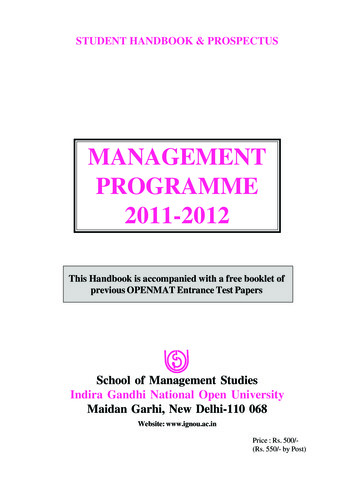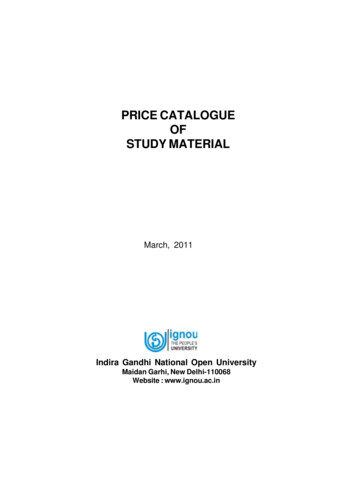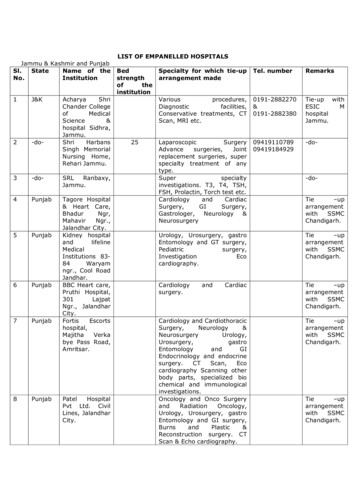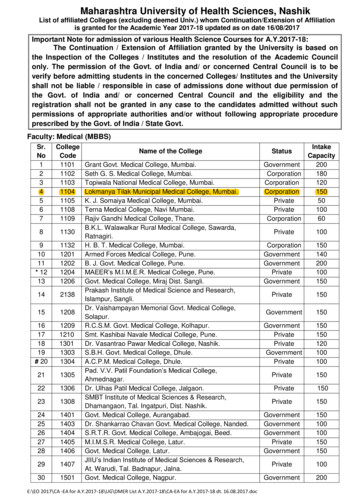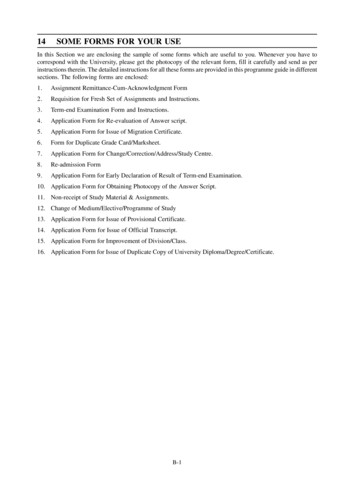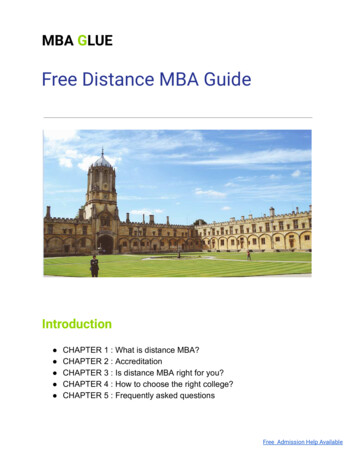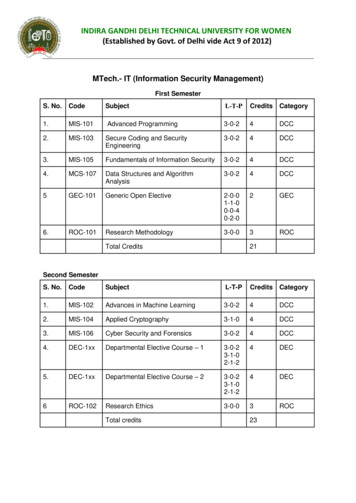
Transcription
INDIRA GANDHI DELHI TECHNICAL UNIVERSITY FOR WOMEN(Established by Govt. of Delhi vide Act 9 of 2012)MTech.- IT (Information Security Management)First SemesterS. d Programming3-0-24DCC2.MIS-103Secure Coding and SecurityEngineering3-0-24DCC3.MIS-105Fundamentals of Information Security3-0-24DCC4.MCS-107Data Structures and AlgorithmAnalysis3-0-24DCC5GEC-101Generic Open Elective2-0-01-1-00-0-40-2-02GEC6.ROC-101Research Methodology3-0-03ROCTotal Credits21Second SemesterS. s in Machine Learning3-0-24DCC2.MIS-104Applied Cryptography3-1-04DCC3.MIS-106Cyber Security and Forensics3-0-24DCC4.DEC-1xxDepartmental Elective Course – 13-0-23-1-02-1-24DEC5.DEC-1xxDepartmental Elective Course – 23-0-23-1-02-1-24DEC6ROC-102Research Ethics3-0-03ROCTotal credits23
Third SemesterS. No.CodeSubjectL-T-PCreditsCategory1.MIS-201Ethical Hacking3-0-24DCC2.DEC-2xxDepartmental Elective-33-0-23-1-02-1-24DEC3.DEC-2xxDepartmental Elective-43-0-23-1-02-1-24DEC4GEC-201General Open Elective2-0-01-1-00-0-42GEC5MIS-251Dissertation – I/Project Work-8DCC6MIS-253Industrial Training/Internship-1DCCTotal credits23Fourth SemesterS.No.CodeSubject1.MIS-252Dissertation – II/Project WorkTotal creditsL-T-P-Credits2020CategoryDCC
List of Departmental Elective CoursesCategoryCourse CodeSubjectCreditsDepartmentalMIS-108Adv. Database Management Systems3-0-2Elective Course-1MIS-110Introduction to Biometrics3-0-2MIS-112Computer Vision3-0-2MIS-114Blockchain Fundamentals3-0-2DepartmentalMCS-106Probability and Random Process3-0-2Elective Course-2MIS-118Semantic Web3-1-0MIS-120Security Testing and Risk Management3-0-2MIS-122Natural Language Processing and Information3-0-2RetrievalDepartmentalMIS-203Neural Network and Deep Learning3-0-2Elective Course-3MIS-205Security Patterns3-0-2MIS-207Cryptographic Protocols and Algorithms3-0-2MIS-209Advanced Network Technology3-0-2DepartmentalMIS-211Cyber Laws and Rights3-1-0Elective Course-4MIS-213Security and Privacy in Social Networks3-1-0MIS-215Software Defined Networks3-1-0MIS-217Cloud Computing Architecture and Security3-0-2
Advanced programmingCourse Code: MIS-101Credits:4Contact Hours: L-3 T-0 P-2Semester:1Course Category: DCCIntroduction: This course is designed to enable students to recognize the need for distributed,transactional and portable applications that leverage speed, security and reliability of server sidetechnologies. This course shall inculcate programming capability to handle business logic anddevelop and deploy applications using Java Platform, Enterprise Edition.Course Objective To learn Software Development and Deployment that is reliable, scalable and portable.To learn object oriented programming through Design Patterns.To learn secure integrating web applications developed on varied platform through webservices technologies.Pre-requisite: Basic Knowledge of Object Oriented programming, Java Programming Language andDatabase ManagementCourse Outcome: Upon successful completion of this course, students will be able to: Acquire Software development skills that are reliable, scalable and portable applications.Design and implement software development with Clean Code through use of Designpatterns and MVC Framework.Implement web services application for transacting web applications built on variedplatformsImplement security features available in enterprise edition of Java EE8.PedagogyLectures will be imparted along with hands on lab sessions and development of a Web Applicationfor case study (ies).ContentsUNIT-I10 HoursIntroduction to Java, Features of Java 8 and EE 8 , Variables, Arrays, Strings, Exception Handling,Multithreading, Collection Framework, Creating Interfaces, packages, JAR Files, Annotations , JDBC.Networking and Security Programming, socket Programming, Session Handling, Remote MethodInvocation,UNIT-II11 HoursWorking with Servlets, Event Handling and Wrappers, Working with Java Beans, bean validation, JavaServer Pages, Expression Languages, JSP Application Development, Tags Extensions and ImplementationJSP Tag Library, Implementing FiltersUNIT-III10 HoursWorking with java Server Faces, Understanding Java Mail, Java EE Design Patterns, Working withHibernate, Struts, Spring MVC, Spring configuration.Case Study such as (Any One): Building an Online Book Store, Online Shopping cart, UniversityManagement System , simple e-commerce application -Forest case StudyUNIT-IV11 Hours
Implement SOA using Java Web Services, JSON Processing, Building Web services with JAX, BuildingSOAP , UDDI, RESTFul services, Working with Glassfish, JBOSS server, JUnit Testing Security in JAVA EE.Text Books1Jim Koegh, “Java EE Complete Reference”, Mc Graw Hill , First Edition, 20172“Core and Advanced Java, Black Book”, DreamTech Publications, First Edition, 20183Java Platform, Enterprise Edition 8: The Java EE Tutorial, Oracle, Java Documentation, 2018Reference Books1David R. Heffelfinger, “Java EE 8 Application Development”, Packt Publishing, First Edition,December 2017
Secure Coding and Security EngineeringCourse Code: MIS-103Credits : 4Contact Hours: L-3 T-0 P-2Semester: 1Course Category: DCCIntroduction: Security breaches in software are costing companies large fines and regulatoryburdens. Developing software, that is reliable in its functionality, resilient against attackers, andrecoverable when the expected business operations are disrupted, is a must have. The assurance ofconfidentiality, integrity and availability is becoming an integral part of software development. Thiscourse is being introduced to integrate security principles and secure programming with Softwaredevelopment to reduce effort in removing basic vulnerabilities and risk thereby. The course iseffective in enabling students to learn and develop software that is reliable and resilient to softwareattacks.Course Objective To learn Secure Software Development Guidelines and Best Practices.To learn secure programming practices so as to build secure software resilient to cyberattacks.To learn secure configuration of various tiers and layers involved in Software Development.Pre-requisite: Basic Knowledge of Programming Language (s), Database Management, Network, ServerCourse Outcome: Upon successful completion of this course, students will be able to: Acquire security requirements with respect to software development.Design and implement software development with minimum software vulnerabilities.Write and test software code with respect to security testing and remove security flaws.PedagogyLectures will be imparted along with hands on lab sessions and latest real world case studies aboutsoftware vulnerabilities reported, prevention and patching techniques.ContentsUNIT-I10 HoursSecure software development life-cycle: Software development life cycle (Microsoft, McAfee, OWASPetc), development team, Quality and Security, Application Guidelines, (ISC)2 Ten best practices of securesoftware development, Security principles, Security Standards Three pillars of software security, SevenTouch points of software security, Security Methodologies, Security Framework, Security ModelsUNIT-II10 HoursSecure Software Requirements: Introduction, Objective, Sources, Types of Security Requirements,Requirements Engineering for Secure Software, Concepts of Misuse and Abuse, SQUARE Process Model,SQUARE Sample Outputs, Requirements Elicitation and Prioritization, Object Modeling, Threat ModelingSecure Software Design: Design Consideration, processes, Architecture, technologies,UNIT-III12 HoursSecure Software Implementation, : Introduction to Software Vulnerability and Preventive/ Defensivetechniques , Vulnerability description, types, Vulnerability Databases, OWASP top 10, NVD, CWE,Common Software Vulnerabilities and Controls, Defensive Coding Practices—Concepts and Techniques :Buffer Overrun, Format String Problems, Integer Overflow, and Injection flaws : SQL Injection, Command
Injection, Failure to Handle Errors, Cross Site Scripting, Broken Authentication and SessionManagement, Magic URLs, Weak Passwords, Failing to Protect Data, Weak random numbers, improperuse of cryptography, Insecure Direct Object References, Insecure De-serialization, Security Misconfiguration, Information Leakage, Race Conditions, Poor Usability, Not Updating Easily, Executing withtoo much privilege, Failing to protect network traffic, improper use of PKI, trusting network nameresolutionUNIT-IV10 HoursSecure Coding Standards: Memory Management, Exception management, Development tools, IDEstools, Versioning tools, Networking tools, Coding in the cube: Functions, procedures and code blocks,Structuring for Validation, Structured Programming, Debugging, Coding and applying securityrequirements during maintenance,Security code analysis and review: Code review with a tool (fortify, coverty etc), Code analysisSecuring Server, Database, Network and their secure configuration, Firewalls,Case Study : Recent Software vulnerabilities due to insecure programming and how to prevent themduring design and implementationText Books1Paul, M. (2016). Official (ISC) 2 Guide to the CSSLP. CRC Press.2SEACORD, R. (2013). Secure Coding in C and C (2nd Edition). SEI Series in Software Engineering3Howard, Michael, David LeBlanc, and John Viega. "24 Deadly Sins of Software Security."Programming Flaws and How to Fix Them (2010). McGraw-Hill EducationReference Books1Ransome, J., & Misra, A. (2018). Core software security: Security at the source. CRC press.2Bishop, M. (2019). Computer Security(2nd Edition). Addison-Wesley Professional.3McGraw, G. (2006). Software security: building security in (Vol. 1). Addison-Wesley Professional4John Veiga, Gary Mc Graw, “Building Secure Software: How to Avoid Security Problems the RightWay”, Addison-Wesley Professional Computing Series, 2001
Course Code: MIS-105Contact Hours: L-3 T-0Course Category: DCCFundamentals of Information SecurityCredits: 4P-2Semester: 1Introduction:This course will introduce students to fundamentals of information security, cryptography,access control mechanisms, system attacks and defences against themCourse Objective: Analyze the vulnerabilities in any computing system and hence be able to design asecurity solutionIdentify the basic security issues in the computer network communicationsEvaluate various security mechanisms used in real worldPre-requisite: NoneCourse Outcome: Learn information security basicsLearn to use and apply various security mechanisms to real world problemsPedagogy: Lecture, Power point Slides, Online Material, AssignmentsContentsUNIT-I10 HoursSecurity Overview, CIA model, Threats, Policy and Mechanisms, Security Policies,Confidentiality Policies, Integrity Policies, Hybrid Policies, Cryptography Basics, ClassicalCryptosystems, Stream Ciphers and Block Ciphers, Public Key Cryptography: RSAUNIT-II11 HoursCryptographic Checksums , Authentication Basics, Password management, ChallengeResponse, Biometrics, Key Exchange, Certificate Chains, X.509, Digital Signatures, AccessControl Lists: Creation and Maintenance, Revocation of Rights, Ring based Access ControlUNIT-III11 HoursMalicious Logic, Trojan Horses, Viruses, Worms, Logic Bombs, Defenses, Sandboxing,Intrusion Detection: Principles and Basics, Anomaly modelling, Architecture: Host andnetwork based Information Gathering, Organization of Intrusion Detection Systems,Intrusion ResponseUNIT-IV10 HoursFirewalls and Proxies, DMZ server, User Security: Policy, Access, Files and Devices,Processes, Electronic Communications, Program Security: Requirements and Policy,Design, common security related programming problems, Virtual Machines StructureText Books1Matt Bishop, S.S. Venkatramanayya, “Introduction to Computer Security,
Addison-Wesley Professional, 3rd Ed., 20052W Stallings, “Cryptography and Network Security: Principles and Practice, PrenticeHall, 6th Ed. 2014Reference Books1B. Forouzan, D. Mukhopadhyay, "Cryptography and Network Security", McGrawHill, 3rd Ed., 2011
RESEARCH METHODOLOGYCourse Code: ROC-101Contact Hours: L-2 T-0Course Category: ROCCredits: 3Semester: 1P-2Introduction: The course introduced the students to the research world. They willunderstand how to read and interpret a research papers. Also this course will make thenunderstand how to write their own research proposals.Course Objectives: The purpose is to align the M. Tech. students with the research process of the rest ofthe world so that when they go for higher studies either in university or industry ,they should be aware of how to communicate their research to the rest of the worldand how to read and interpret the research work of others. The students will also become aware of metrics of how to evaluate the quality ofdifferent research works. The practical statistical tools will enhance their skills to apply mathematical tools totheir research to interpret results and communicate in a common jargon.Course Outcomes: Having successfully completed this course The students will be able to write their own research proposal. They will also have familiarity with research journals, how do the whole processworks right from draft of a research paper to reviewer comments and publishing.Pedagogy: Classroom teaching which focuses upon relating the textbook concepts with realworld phenomena, along with regular tutorial classes to enhance the problem-solving ability.ContentsUNIT-I10 HoursObjectives and Motivation of Research, Types of Research, Research Approaches,Significance of Research, Research Methods verses Methodology, Research and ScientificMethod, Important of Research Methodology, Research Process, Criteria of Good Research,Problems Encountered by Researchers in India, Benefits to the society in general. Definingthe Research Problem: Definition of Research Problem, Problem Formulation, Necessity ofDefining the Problem, Technique involved in Defining a Problem.UNIT-II10 HoursLiterature Survey: Importance of Literature Survey, Sources of Information, Assessment ofQuality of Journals and Articles, Information through Internet, Significance of ISSN, DOI,Impact Factor, Citations. Rules of Citation.Research Design: Meaning of Research Design, Need of Research Design, Feature of a GoodDesign, Important Concepts Related to Research Design, Different Research Designs, Basic
Principles of Experimental Design, Developing a Research Plan, Design of Experimental Setup, Use of Standards.UNIT-III11 HoursDescriptive Statistics, Points of Central tendency, Measures of Variability, Measures ofrelationship, Inferential Statistics-Estimation, Hypothesis Testing.How to read data from multiple files, Interpretation of Data: Univariate Analysis, Tests forsignificance: Chi square, t-test, Regression modeling, Direct and Interaction effects,ANOVA, F-test, Time Series analysis, Autocorrelation and Autoregressive modeling.Inferential statistics: Normal Curve, Confidence Interval, Type1 and Type 2 errors.UNIT-IVResearch Report Writing: Format of the Research report, Style ofReferences/Bibliography/Webliography, Technical paper writing/Journal report writing.11 Hourswritingreport,Survey Methods: Questionnaire method; Types of Questionnaires; Process of Questionnaire Designing;Advantages and Disadvantages of Questionnaire Method.Text Books1.C.R Kothari, “Research Methodology, Methods & Technique”; New AgeInternational Publishers, 20042.R. Ganesan, “Research Methodology for Engineers”, MJP Publishers, 20113.Y.P. Agarwal, “Statistical Methods: Concepts, Application and Computation”,Sterling Publs., Pvt., Ltd., New Delhi, 20044.Vijay Upagade and Aravind Shende, “Research Methodology”, S. Chand &Company Ltd., New Delhi, 2009
DATA STRUCTURES AND ALGORITHM ANALYSISCourse Code: MCS- 107Credits: 4Contact Hours: L-3 T-0 P-2Semester: 1Course Category: DCCIntroduction: This course is about teaching of various data structure designs & itsimplementations, analyzing the various algorithm strategies and designing of new algorithms forvarious classes of problems. It is intended to be a gentle introduction to how we specify datastructure, algorithms, some of the design strategies, and many of the fundamental ideas used inalgorithm analysis throughout the syllabus.Course Objective: To build an understanding on the basics of core and advance data structure. To introduce the various strategies used in the algorithm design and their analysis. TO teach the selection of data structure for a particular problem To teach students, how to write complex program using dynamic data strcutres Pre-requisite: Students should have some programming experience. In particular, they shouldunderstand recursive procedures and simple data structures such as arrays and linked lists.Students should have some facility with proofs by mathematical induction.Course Outcome: After studying this course, Students will be able to : Successfully design and implements the core and advance data structures Successfully analyses the complexity associated with the various data structures Analyse, design and implements the various proposed algorithm based on differentalgorithmic strategies. Choose data structures for various complex problems Pedagogy : Classroom teaching which focuses on developing understanding of students todigest the concepts of subject with large number of examples.ContentsUNIT-I10 HoursAlgorithms performance analysis: Time and space complexity, Asymptotic Notations,Complexity Analysis Examples. Linear Data Structures: Arrays, Stacks, Queues,Linked lists, Recursion: Solving recurrences.UNIT-II10 HoursNon-linear Data Structure: Trees, Traversals, Binary Search Trees, AVL tree, Btrees, B Tree, Red Black Tree.Graph Algorithms: DFS, BFS, Minimum Spanning Tree Algorithms, Shortestpath Algorithms.13
UNIT-III12 HoursSorting and Searching Algorithms: Quick Sort, Merge Sort, Heap sort; Linear Searchand Binary Search. Hashing: Hashing Functions, Collision Resolution TechniquesUNIT-IV10 HoursAlgorithm Strategies: Greedy paradigm with examples. Divide and conquer paradigmwith examples. Dynamic-programming paradigm with examples. NP Completeness: P,NP, NP-complete, NP-Hard categories of problems, Cook’s theorem.Text Books1Y. Langsam et. al., “Data Structures using C and C ”, Second Edition, PHI,2015.2E. Horowitz, S. Sahani, Anderson-Freed “Fundamentals of Data Structures in C”,Second Edition, University Press, 20083T. H. Cormen, C. E. Leiserson, R. L. Rivest, Clifford Stein, “Introductionto Algorithms”, 3rd Ed., PHI, 2011.Reference Books1R. L. Kruse, B. P. Leung, C. L. Tondo, “Data Structures and program design in C”,PHI, 2010.2Ellis Horowitz and Sartaz Sahani, “Fundamental of Computer Algorithms”,Galgotia Publications, 2009.3A. V. Aho, J. E. Hopcroft, J. D. Ullman, “The Design and Analysis ofComputer Algorithms”, Addition Wesley, 2009.4D. E. Knuth, “The Art of Computer Programming”, 2nd Ed., Addison Wesley,2011.Suggestive List of experiments ( More programs can be added to this list)1. Write a program that Implement Single Link List with following operations: i) Insertionof a node at first node, at any position and at end of list. ii) Deletion of a node at start, atmiddle and at end of list. iii) Display the link list. iv) Count the number of nodes in thelink list. v) Search a node in the link list. vi) Sort the link list. vii) Reverse the link list.2. Write a program that Implement Stack with all primitive operations by using Array.Implement Queue with all primitive operations by using Array.3. Write a program that Implement Stack and Queue with all primitive operations by usinglink list.4. Write a program that Implement doubly link list with primitive operations: (i) Create adoubly linked list (ii Insert a new node to the left of the node. (iii) Delete the node of agiven data. (iv) Display the contents of the list.
5. Write a program that Implement Circular link list with primitive operations. (i) Creationof the Circular list (ii) Insertion of the node (iii) Deletion an element (iv) Display the list6. Write a program that Implement Binary Search Technique.7. Write a program that Implement AVL tree and Red Black Tree.8. Write a program that Implement Binary Tree and its Traversal.9. Write a program that Implement BFS & DFS over a graph.10. Write a program that Implement shortest path algorithms.11. Write a program that Implement Quick Sort, Merge Sort and Heap Sort.12. Write a program that implement Disjoint Set Data Structure13. Write a program that implements Knapsack Problem.14. Write a program that implements Huffman Coding15. Write a program to implement Prim’s and Kruskal's Algorithm16. Write a program to implement Matrix Chain Multiplication Algorithm17. Write a program to implement Longest Common Subsequence Algorithm.18. Write a program to implement All Pair Shortest Path Algorithm.
MTech.- IT (Information Security Management) First Semester S. No. Code Subject L-T-P Credits Category 1. MIS-101 Advanced Programming 3-0-2 4 DCC 2. MIS-103 Secure Coding and Security Engineering 3-0-2 4 DCC 3. MIS-105 Fundamentals of Information Security 3-0-2 4 DCC 4. MCS-107 Data Structures and Algorithm Analysis 3-0-2 4 DCC
